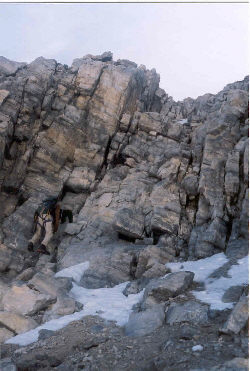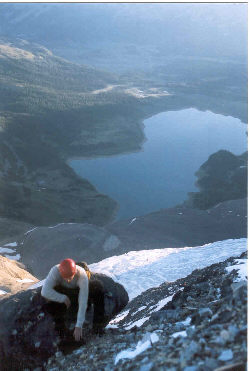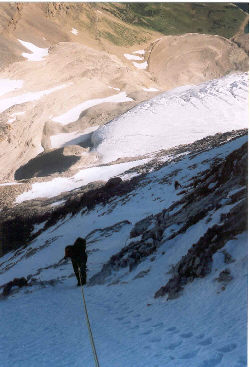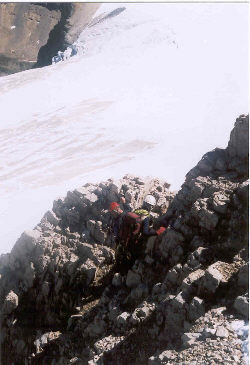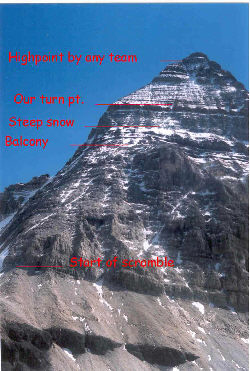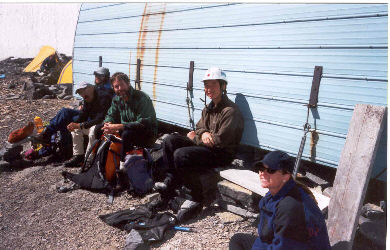|
||||||||||||||||||||
|---|---|---|---|---|---|---|---|---|---|---|---|---|---|---|---|---|---|---|---|---|
Banff Assiniboine Expedition IAugust 12, 2002 – Climbing Mount Assiniboine
When Diana made the call to the Assiniboine Lodge to obtain space in the Hind Hut, she was advised that the peak was providing winter climbing conditions. As I mentioned earlier, the weather had been unseasonably cold and rainy, at Assiniboine this translated into snow and ice. The guidebooks make mention of the effect of snow on the peak, which normally is a class 3 scramble with two sections of class 5.5 climbing through prominent cliff bands. The book says winter conditions substantially increase the challenge of reaching the summit and in hindsight, I would certainly agree with the guidebook. Our review of the route through binoculars showed a snow-covered scramble with snowfield routes available in many places. We did not know however, how much of the peak was coated with verglas, which would certainly turn even a class 3 scramble into a much more rigorous and risky climbing effort.
In addition to the obvious snow and ice, there appeared to be no less than 20 climbers planning for the same alpine start we had in mind. Given the danger of rock fall, we were more than a bit concerned about being beaned in exchange for what may have been precious little altitude gain on the peak. When we turned in the night before, we knew that the group from BC would be up at three and out the door ½ hour later, followed by the Alberta group. Gary and I figured to snag the 4:30 departure slot and hopefully those ahead of us would cry out if they let one loose and there would be enough light to see the incoming rounds if warning was given. That at least was the plan.
The first groups rose at three and made steady progress out the door. At 4, we were up and stepped outside into the crisp air and took a look at the stars above and the headlamps dancing across the flank of the peak and the moraine just below. We were definitely going to be far from alone if we chose to climb. Also up were the Brits and we figured that if today was a climbing day, it had to start now or never. It began.
We crossed the moraines and slogged our way up the loose talus slope on the far side of the valley to approach the first scramble, which breaches the cliff band that guards the base of the northeast ridge. This side of the peak has two routes, the northeast ridge and the north face, both rated at about 5.5. We selected the normal or ridge route as it would be less challenging and required no crossing of a glacier to access the route. When Assiniboine is in “summer” climbing condition, the route is somewhat of a beaten trail but we soon realized that any cairns or obvious trail was covered by snow this morning. We followed the tracks of the groups ahead and when snowfields were available, we too took advantage of steps kicked by others to avoid the snowy scrambles.
The Brits caught up and passed us before the introductory cliff band but as the terrain steepened, we were right behind them, forming an informal party of six to minimize the rock fall danger. Not that much rock was not coming from above, as evidenced by the sharp crack here and there of a pebble or shard hitting the plastic of a climbing helmet worn by a lower party. However, this climb had attracted seasoned climbers and when a rock of any size was let loose, a yell followed allowing those lower to take cover or flatten themselves onto the slope. We eventually made it to a flat area atop a buttress approximately 1/3 of the way up the peak from which the groups were starting to climb parallel tracks or consider the possibility of turning their climbs. The Brits were the first to make the call, apparently having lost one member on the moraine approach hours earlier. The two Canadian teams and ourselves continued on as did a solo Japanese climber who was making good progress on the ridge proper while the rest of us began to stray more onto north face routes to climb snow in lieu of rock.
Gary and I climbed above the buttress and took a steep snow gully that appeared to provide optimum access to a break in the red cliff band marking about the 2/3 point of the climb. Our map showed two significant breaks in the cliff and we knew that these both involved class 5+ moves (we had rope and rock pro with us) to negotiate. I took the lead and kicked solid steps for perhaps 200 vertical feet up the 45 to 50 degree route until it petered out in a rock pitch below the cliff break. There was an option to continue but as I went higher, the depth to which I could plunge the shaft of my axe went from all the way to just about half way. I was not comfortable with the security of a self-belay under those conditions and opted to move to the rock.
The rock pitch proved to be lower class 5 with snow and ice, conditions in which I had not climbed before but . . . we came to do alpine mixed climbing and there it was. The holds were solid and clear but climbing with crampons definitely added a twist to the equation. It evolved into one of those pitches where safety awaits above rather than below, though retreat was certainly within our ability and we had the gear on hand to do so. We both made the pitch without problems and stepped onto the 45-degree snow slope protecting the bottom of the red cliff band. Above us was the group from BC, laughing at something, likely our choice of route, as theirs was a better selection. Gary and I were now confronted with the 5.5 climb to break the cliff band, which we both completed with little problem.
Standing atop the band, we joined the BC group in a discussion of the conditions above. The terrain was now changing to a series of downward sloping steps, each covered with loose material, snow, and ice. The BC group had made their way up a portion of the slope but retreated out of concern for the difficulty of making a safe descent. I too went up about 50 feet and came to the same conclusion, climbing up would not be too bad but the trip down, especially if really tired, could be a serious challenge. They set up a double rope rappel and offered us the use of their line if we wanted. I thought to myself, “two ropes in the hand are much more valuable than one in the pack” and threw in my vote to turn the climb.
We rappelled the cliff band and then two of the BC crew opted to traverse along the cliff to the route taken by the Albertans using an alternate cliff break. The other two opted to continue their descent, rappelling down the rock route Gary and I came up and then making a second rappel down the snow route we ascended. We formed a group of four and completed the two rappels without incident, content to log the mixed alpine experience in lieu of a more risky push toward the summit in trying conditions. From the base of the rappel, we cramponed our way down the remaining snowfields to the shoulder/balcony where we picked up two idiots who had exceeded their abilities to make an understatement. These bozos were 1/3 of the way up the peak, one with food and water, the other without even a pack, neither had crampons, ice axe, rope or alpine experience. They were knocking rock loose left and right, so rather than climb down past them, we told them to come down with us, an offer they gladly accepted. We continued down, bozos in tow, until we reached the easier scramble portion of the peak whereupon the clowns moved off on their own below us. In hindsight, they were two lucky dudes as they had chosen to follow the tamest of the routes and stuck near the ridge itself. Had they taken our route, which had some very inviting steps, they too would have ended up well onto the north face of the peak but without the option of safely down climbing as we did. They would have been one step from the terminal ride and never known it was coming. We reached the moraine at the base of the climb and moved promptly down the trail to once and for all get out of the bowling alley that this peak places all climbers in. The hut was a welcome sight when we reached it and plopped our weary butts down on a warm bench in the sun, binoculars in hand to watch the progress of the other teams still on the mountain.
As the hours passed, we ate and drank but spent most of our time watching the other groups as they went up and then descended, finally arriving at the hut. There were a total of 21 climbers in 8 different teams on Assiniboine and as each one came to the hut, those already there asked if they summitted. The answer to a climber was no. Beginning with the Brits and passing through our mid day turn and lasting until the last tired pair arrived at close to 7 in the evening, the story was the same, one of pushing to the point of too much snow, ice, or exposure and finally making the decision to turn and ensure the opportunity to take a shot at Assiniboine another day.
|

